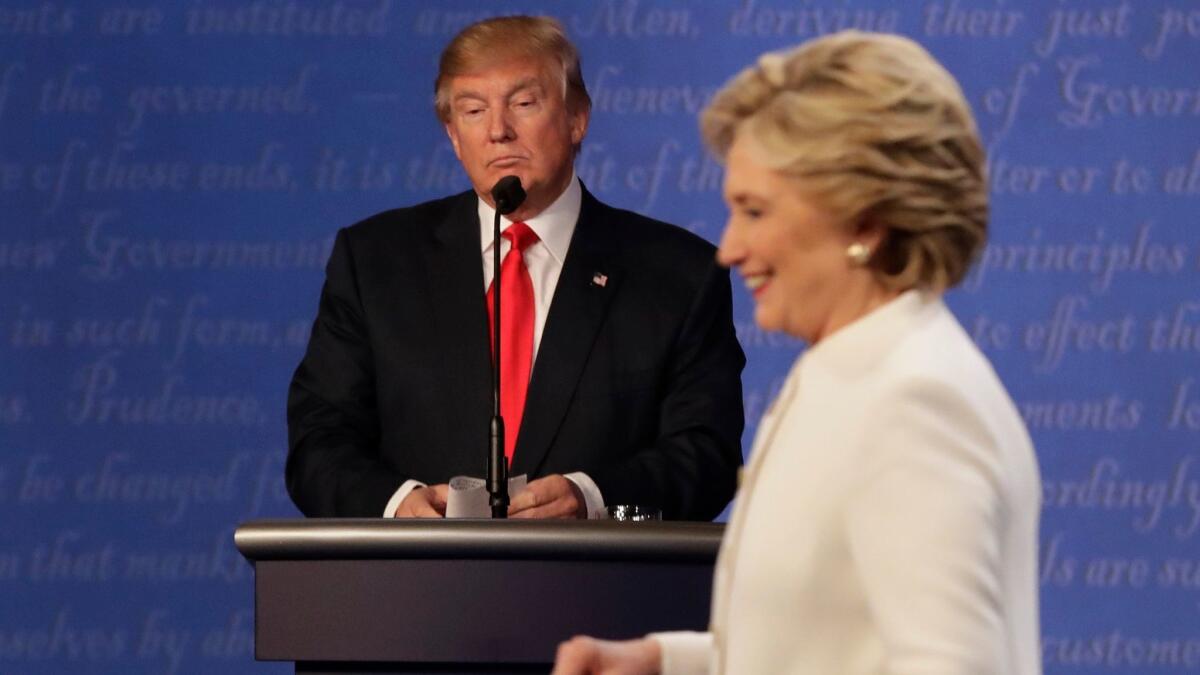Op-Ed: Did the media help Trump win? Look at the numbers

As the 2016 presidential campaign careened toward the November balloting, Donald Trump, who was down in the polls, tweeted that the “election is being rigged by the media, in a coordinated effort with the Clinton campaign.”
If that’s true, journalists had a peculiar way of showing it. On topics related to the candidates’ fitness for office — their policy positions, personal qualities, leadership abilities, ethical standards and the like — Hillary Clinton’s coverage was identical to Trump’s — 87% negative to 13% positive.
From the end of the party conventions through election day, our research team at the Shorenstein Center studied the campaign coverage on five television networks and in five major newspapers. What we found is that the news media had a strong bias toward negative coverage and didn’t make a concerted effort to explain the relative magnitude of the allegations leveled at the two candidates.
Journalists reported all the ugly stuff they could find, and left it to the voters to decide what to make of it.
Clinton’s single source of “good press” during the general election was the horse race. She led in the polls during nearly the whole period, which brought her favorable coverage.
Aside from that, there was no good news to be had for Clinton. Stories about her personal traits portrayed her as overly cautious and guarded and ran 3 to 1 negative. News reports on her policy positions trended negative by a ratio of 4 to 1. Everything from her position on healthcare to her position on trade was criticized, often in the form of an attack by Trump.
Even Clinton’s record of public service, which might have been a source of positive press, turned out not to be. News reports on that topic were 62% negative to 38% positive, with Trump having a larger voice than Clinton did in defining the essence of her career. He was quoted widely as saying, “She’s been there 30 years and has nothing to show for it.”
Journalists couldn’t get enough of the various controversies that bedeviled Clinton — her private server, Benghazi and the like. There was no week in which they accounted for less than 7% of her coverage and, in the campaign’s final week, they constituted more than a third of her coverage.
News reports on these controversies ran 19 to 1 negative over positive. Was Clinton’s merging of her personal and official emails, which had also been the practice of other top officials, an egregious and possibly disqualifying error of judgment? The question went unanswered, as journalists focused instead on the toll the scandals were taking on her support and on the “Lock her up” chant that resounded at Trump rallies.
Clinton’s alleged scandals accounted for 16% of her coverage, and were mentioned 16 times as much as her most heavily covered policy stand — her position on trade. It too was hammered in the news — 16 to 1 negative, with the attacks coming from Trump and Sen. Bernie Sanders supporters alike. Rarely in the news was she given the time or space to voice her side of the issue.
Journalists covered the campaign without difference or discrimination. Judging from the amount of negative coverage they received, there was not a dime’s worth of difference between the Clinton Foundation and the Trump Foundation. By the same scale, Clinton’s emails ranked far ahead of Trump’s treatment of women, his tax returns, his business dealings or his remarks about Muslims.
Journalists like to say that they’ve never seen an election like this one. In a sense, that’s true. But in terms of the pattern of news coverage, it was business as usual. Lots of horse race, lots of controversy, very little attention to the candidates’ platforms. And tons of negativity.
Research studies indicate that the last time the two major-party nominees received on balance more positive coverage than negative coverage was 1984, when Ronald Reagan and Walter Mondale faced off. As political scientist Michael Robinson wrote, the news media seem to have taken some motherly advice and turned it on its head. “If you don’t have anything bad to say about someone, don’t say anything at all.”
Journalists defend themselves by saying they bash both sides. True enough. But indiscriminate criticism has the effect of false equivalencies. If the press historically has helped citizens recognize the difference between the earnest politician and the pretender, that function has been lost in the media feeding frenzies that take place around even tiny transgressions.
Were the allegations surrounding Clinton of the same order of magnitude as those surrounding Trump? Don’t look to the news for the answer to that question. Journalists reported all the ugly stuff they could find, and left it to the voters to decide what to make of it. Large numbers of voters concluded that the candidates were equally bad.
Thomas E. Patterson is the Bradlee Professor of Government and the Press at the Harvard Kennedy School.
Follow the Opinion section on Twitter @latimesopinion and Facebook
More to Read
A cure for the common opinion
Get thought-provoking perspectives with our weekly newsletter.
You may occasionally receive promotional content from the Los Angeles Times.










